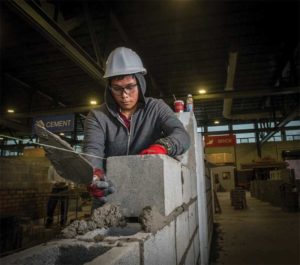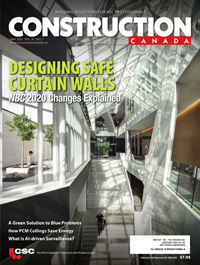Masonry: 10 tips from the field
 By Brian E. Trimble, P.E., CDT, LEED AP, FASTM, and David Sovinski
By Brian E. Trimble, P.E., CDT, LEED AP, FASTM, and David Sovinski
Each project is unique, but there are some common mistakes, problems, and inefficiencies that occur on a regular basis, affecting the cost, schedule, or performance of building enclosures.
Understanding material qualities and resultant performance is the core of good masonry construction. Common misunderstandings about the basic material of masonry, clay masonry, or brick can be better understood by reading ASTM C216-19, Standard Specification for Facing Brick (Solid Masonry Units Made from Clay or Shale).
While there are many important requirements in this standard, studying two tables will eliminate many common issues and potentially costly mistakes. Bricks are subject to chipping. Think about the manufacturing process involving tumbling, firing, packaging, and the actual delivery. Once the brick gets to a jobsite, it may be handled several times before actually being placed into service in a wall. Potential for chipping is high, and ASTM C216-19 recognizes this. Figure 1 details chippage allowances.
Minimizing how often a brick is handled is important not only for chippage, but also for the productivity of a mason contractor, since time spent on transportation logistics can quickly add up. Dan Schiffer, former president of Schiffer Mason Contractors even commented, “I am not always a mason contractor, but often a transportation contractor”.
Tip 1: Understand brick crack allowances
When viewing a FBS brick wall for allowable cracks, the general requirement is to stand 6 m (20 ft) away in diffused lighting and check for visible cracks or imperfections. More stringent standards for FBX brick allow for 4.5-m (15-ft) viewing distance. A close examination will likely show some imperfections. This may be fine with the design intent, since as one architect explained, “that is part of the romance of brick…”

Tip 2: Realize bricks have dimensional tolerances
Table 2 of ASTM C216-19 (see Figure 2) shows the dimensional tolerances of brick.
A trained mason will space out the brick in a wall and make up the differential with wider or narrower head joints, resulting in an esthetically pleasing appearance while minimizing excessively large mortar joints.
Including detailed requirements for a mockup of the masonry wall system will help define expectations. The mockup should include, but not be limited to, all masonry accessories, showing how they interact with other materials, the brick, including range of colour, size, shape, and texture, and finally, the expected workmanship. Imagine inspecting a commercial project with 100,000 bricks, which would have nearly a mile-and-a-half of mortar joints. Measuring each brick or mortar joint is more difficult than assessing the overall appearance by comparing to a masonry mockup.
Concrete masonry is typically specified by referring to ASTM C90-16a, Standard Specification for Loadbearing Concrete Masonry Units. The viewing distance for imperfections is again 6 m under diffused lighting. Dimensional variance is +/– 3 mm (0.125 in.) from the specified dimensions. Again, comparing the installed product to an approved mockup is an effective method of determining quality.







